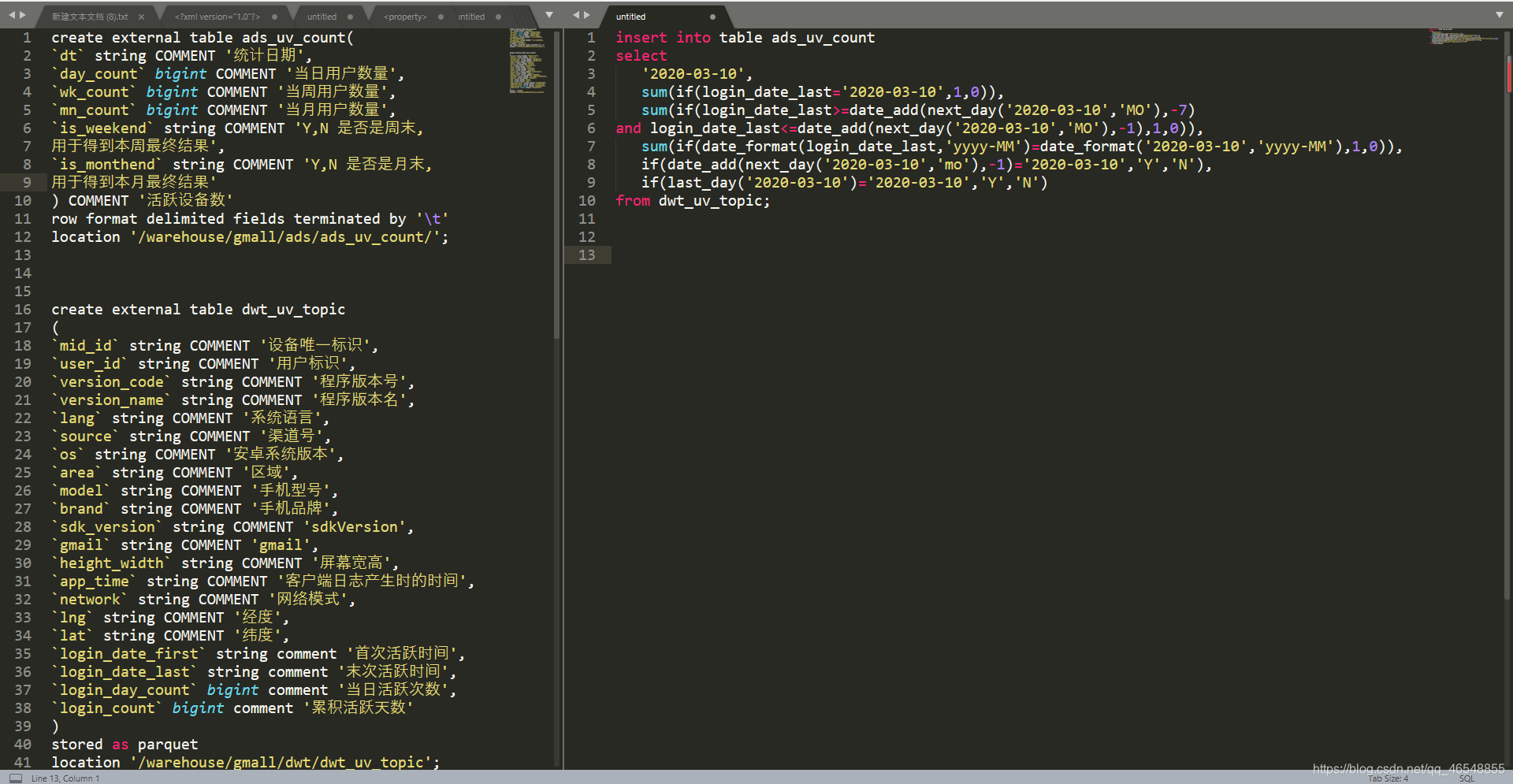目录
设备主题
活跃设备数(日、周、月)
需求定义:
日活:当日活跃的设备数
周活:当周活跃的设备数
月活:当月活跃的设备数

每日新增设备

沉默用户数
需求定义:
沉默用户:只在安装当天启动过,且启动时间是在 7 天前

本周回流用户数
需求定义:
本周回流用户:上周未活跃,本周活跃的设备,且不是本周新增设备
DWT层拿不到历史数据,所以往DWS拿数据

解释一下最后一排为啥where last_wk.mid_id=null

流失用户数
需求定义:
流失用户:最近 7 天未活跃的设备

留存率


最近连续三周活跃用户数

解释having count(*)=3 因为三周所以三个1

最近七天内连续三天活跃用户数
思路一 根据dt-rank来算相同的时间


思路二 dt-lead=2说明三天连续


会员主题
会员主题信息
会员新鲜度=新增会员数/活跃会员数

漏斗分析
统计“浏览->购物车->下单->支付”的转化
思路:统计各个行为的人数,然后计算比值。

商品主题
商品个数信息
sku不去重 spu要去重 在业务中尽量不要使用count(distinct(spu))

商品销量排名
求前十

商品收藏排名

商品加入购物车排名

商品退款率排名(最近 30 天)

商品差评率

营销主题(用户+商品+购买行为)
下单数目统计
需求分析:统计每日下单数,下单金额及下单用户数

支付信息统计
每日支付金额、支付人数、支付商品数、支付笔数以及下单到支付的平均时长(取自DWD)
运用了3张表

复购率
需求各一级品类下月品牌复购率

各个阶层的代码
insert into table ads_continuity_wk_count
select
'$do_date',
concat(date_add(next_day('$do_date','MO'),-7*3),'_',date_add(next_day('$do_date','MO'),-1)),
count(*)
from
(select
mid_id
from
(
select
mid_id
from dws_uv_detail_daycount
where dt>=date_add(next_day('$do_date','MO'),-7)
and dt<=date_add(next_day('$do_date','MO'),-1)
group by mid_id
union all
select
mid_id
from dws_uv_detail_daycount
where dt>=date_add(next_day('$do_date','MO'),-7*2)
and dt<=date_add(next_day('$do_date','MO'),-1-7)
group by mid_id
union all
select
mid_id
from dws_uv_detail_daycount
where dt>=date_add(next_day('$do_date','MO'),-7*3)
and dt<=date_add(next_day('$do_date','MO'),-1-7*2)
group by mid_id
)t1
group by mid_id
having count(*)=3)t2;
insert into table ads_continuity_uv_count
select
'$do_date',
concat(date_add('$do_date',-6),'_','$do_date'),
count(*)
from
(select
mid_id
from
(select
mid_id,
datediff
from
(select
mid_id,
(lead-dt) datediff
from
(select
mid_id,
dt,
lead(dt,2,'1970-01-01') over(partition by mid_id order by dt) lead
from dws_uv_detail_daycount)t1)t2
where datediff=2)t3
group by mid_id)t4;
insert into table ads_user_topic
select
'$do_date',
sum(if(login_date_last='$do_date',1,0)),
sum(if(login_date_first='$do_date',1,0)),
sum(if(payment_date_first='$do_date',1,0)),
sum(if(payment_count>0,1,0)),
count(*),
sum(if(login_date_last='$do_date',1,0))/count(*),
sum(if(payment_count>0,1,0))/count(*),
sum(if(login_date_first='$do_date',1,0))/
sum(if(login_date_last='$do_date',1,0))
from dwt_user_topic;
insert into table ads_user_action_convert_day
select
uv.dt,
uv.day_count,
cart_count,
cart_count/uv.day_count,
order_count,
order_count/cart_count,
payment_count,
payment_count/order_count
from
(
select
'$do_date' dt,
sum(if(cart_count>0,1,0)) cart_count,
sum(if(order_count>0,1,0)) order_count,
sum(if(payment_count>0,1,0)) payment_count
from dws_user_action_daycount
where dt='$do_date'
)ua
join ads_uv_count uv
on ua.dt=uv.dt;
insert into table ads_product_info
select
'$do_date' dt,
sku_num,
spu_num
from
(
select
'$do_date' dt,
count(*) sku_num
from dwt_sku_topic
)tmp_sku_num
join
(
select
'$do_date' dt,
count(*) spu_num
from
(
select
spu_id
from
dwt_sku_topic
group by spu_id
)tmp_spu_id
)tmp_spu_num
on tmp_spu_num.dt=tmp_sku_num.dt;
insert into table ads_product_sale_topN
select
'$do_date',
sku_id,
payment_amount
from dws_sku_action_daycount
where dt='$do_date'
order by payment_amount desc;
insert into table ads_product_favor_topN
select
'$do_date',
sku_id,
favor_count
from dws_sku_action_daycount
where dt='$do_date'
order by favor_count desc
limit 10;
insert into table ads_product_cart_topN
select
'$do_date',
sku_id,
cart_num
from dws_sku_action_daycount
where dt='$do_date'
order by cart_num desc
limit 10;
insert into table ads_product_refund_topN
select
'$do_date',
sku_id,
refund_last_30d_count/payment_last_30d_count*100 refund_ratio
from dwt_sku_topic
order by refund_ratio desc
limit 10;
insert into table ads_appraise_bad_topN
select
'$do_date',
sku_id,
appraise_bad_count/(appraise_good_count+appraise_mid_count+
appraise_bad_count+appraise_default_count) appraise_bad_ratio
from dws_sku_action_daycount
where dt='$do_date'
order by appraise_bad_ratio desc
limit 10;
insert into table ads_order_daycount
select
'$do_date',
sum(order_count),
sum(order_amount),
sum(if(order_count>0,1,0))
from dws_user_action_daycount
where dt='$do_date';
insert into table ads_payment_daycount
select
tmp_payment.dt,
tmp_payment.payment_count,
tmp_payment.payment_amount,
tmp_payment.payment_user_count,
tmp_skucount.payment_sku_count,
tmp_time.payment_avg_time
from
(
select
'$do_date' dt,
sum(payment_count) payment_count,
sum(payment_amount) payment_amount,
sum(if(payment_count>0,1,0)) payment_user_count
from dws_user_action_daycount
where dt='$do_date'
)tmp_payment
join
(
select
'$do_date' dt,
sum(if(payment_count>0,1,0)) payment_sku_count
from dws_sku_action_daycount
where dt='$do_date'
)tmp_skucount
on tmp_payment.dt=tmp_skucount.dt
join
(
select
'$do_date' dt,
sum(unix_timestamp(payment_time)-
unix_timestamp(create_time))/count(*)/60
payment_avg_time
from dwd_fact_order_info
where dt='$do_date' and payment_time is not null
)tmp_time
on tmp_payment.dt=tmp_time.dt;
insert into table ads_payment_daycount
select
tmp_payment.dt,
tmp_payment.payment_count,
tmp_payment.payment_amount,
tmp_payment.payment_user_count,
tmp_skucount.payment_sku_count,
tmp_time.payment_avg_time
from
(
select
'$do_date' dt,
sum(payment_count) payment_count,
sum(payment_amount) payment_amount,
sum(if(payment_count>0,1,0)) payment_user_count
from dws_user_action_daycount
where dt='$do_date'
)tmp_payment
join
(
select
'$do_date' dt,
sum(if(payment_count>0,1,0)) payment_sku_count
from dws_sku_action_daycount
where dt='$do_date'
)tmp_skucount
on tmp_payment.dt=tmp_skucount.dt
join
(
select
'$do_date' dt,
sum(unix_timestamp(payment_time)-
unix_timestamp(create_time))/count(*)/60
payment_avg_time
from dwd_fact_order_info
where dt='$do_date' and payment_time is not null
)tmp_time
on tmp_payment.dt=tmp_time.dt;























 2297
2297











 被折叠的 条评论
为什么被折叠?
被折叠的 条评论
为什么被折叠?










